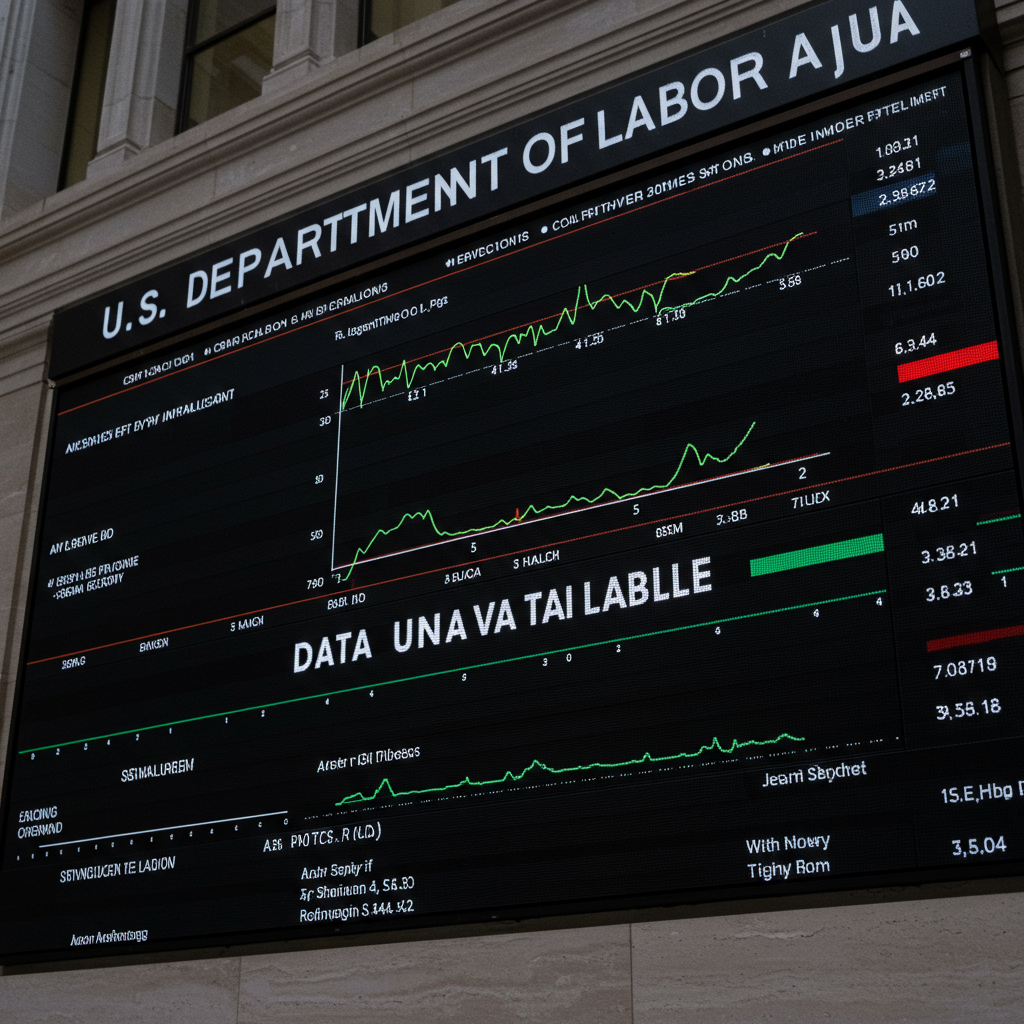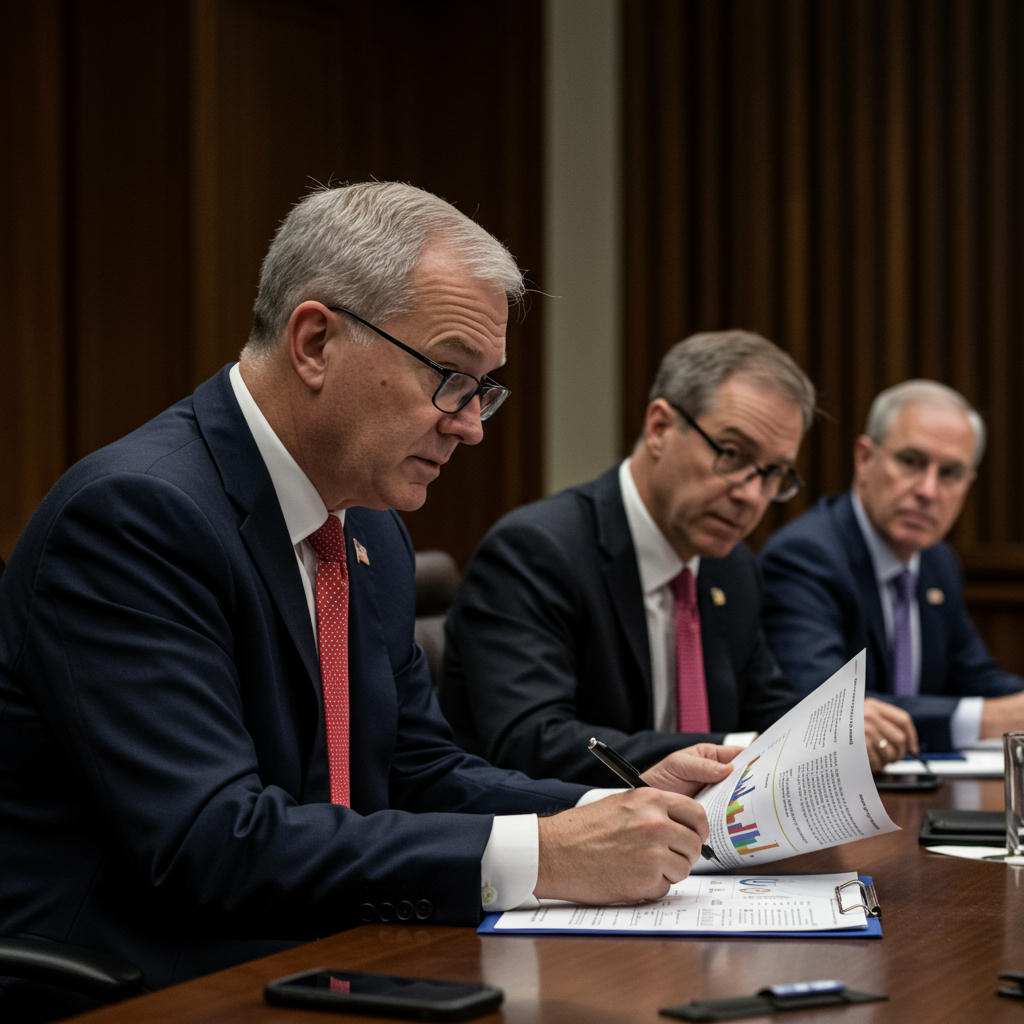As the specter of a U.S. government shutdown looms, the nation faces a critical blackout of essential economic data, casting a shadow of uncertainty over financial markets and monetary policy. With a looming deadline of October 1, 2025, the U.S. Department of Labor (DOL) has confirmed that many crucial reports, including the eagerly awaited monthly jobs report, will be indefinitely delayed if federal operations cease. This disruption could leave policymakers, investors, and businesses “flying blind” at a time when clarity is paramount for navigating complex economic waters.
The Looming Deadline and Political Gridlock
The potential government shutdown, set to commence at 12:01 a.m. on Wednesday, October 1, 2025, stems from a tense congressional standoff. President Trump and top congressional leaders are locked in negotiations, with little sign of immediate resolution. The core of the disagreement revolves around a Republican-backed continuing resolution (CR) proposing a seven-week funding extension. While this bill passed the House, it failed in the Senate, requiring 60 votes and thus Democratic support.
Democrats, led by Senate Minority Leader Chuck Schumer and House Minority Leader Hakeem Jeffries, insist on extending expiring health care subsidies, particularly Affordable Care Act tax credits, which Republicans oppose. Jeffries has termed this a “five-alarm fire,” warning of “skyrocketing premiums” for millions. President Trump, meanwhile, has linked any health care discussions to immigration enforcement, deeming Democratic border policies unacceptable. These entrenched positions make a shutdown highly probable, with Polymarket estimating the odds at over 80%.
Contingency Planning: When Data Goes Dark
The Department of Labor’s 73-page contingency plan, released recently, details the immediate cessation of “non-essential functions” across its agencies. For the financial world, the most pressing consequence is the suspension of all operations by the Bureau of Labor Statistics (BLS). This means economic data scheduled for release during the lapse will simply not be published.
Moreover, active data collection activities for BLS surveys will cease, potentially delaying future reports even after a shutdown concludes. The BLS website itself will not be updated or restored in the event of technical failure. As former chief economist for the DOL, Betsey Stevenson, noted, data collection is not considered essential enough to continue during a government shutdown.
Economic Indicators on Hold: A Data Desert Emerges
The impact on data releases is profound, affecting several key economic indicators that provide vital clues about the direction of the U.S. economy.
Key Reports Facing Delays:
Nonfarm Payrolls Report: Scheduled for release on Friday, October 3, this crucial monthly jobs report provides insights into job growth and the unemployment rate. Economists had anticipated around 50,500 new hires for September, with a forecast unemployment rate of 4.3%. The absence of this data leaves a significant void.
Initial Jobless Claims: Typically released every Thursday, this report offers a weekly snapshot of the labor market’s health.
Consumer Price Index (CPI): Due on October 15, the CPI is a pivotal inflation indicator. Its delay is particularly problematic as it’s the last such reading the Federal Reserve would receive before its critical October 28-29 meeting.
Without these figures, the Fed, economists, and market participants will be left “flying blind” in what Callie Cox, chief market strategist at Ritholtz Wealth Management, describes as a “data desert.”
The Federal Reserve’s Dilemma and Market Ramifications
The timing of this potential data blackout is particularly “awkward” for the Federal Reserve. The Fed, having recently cut interest rates, relies heavily on economic data to inform its monetary policy decisions. Fed Chair Jerome Powell has previously cited labor market “headwinds” as a key factor in recent rate adjustments. The absence of crucial reports, especially the CPI before their October meeting, could significantly complicate their decision-making process.
Mike Reid, a senior U.S. economist at the Royal Bank of Canada, suggests that the increased likelihood of economic reports being unavailable to the Fed before its meeting “increases the probability of an October pause” in additional rate cuts. This uncertainty about the Fed’s trajectory could spur financial market volatility. Jennifer Timmerman, an investment strategy analyst at Wells Fargo Investment Institute, while believing a shutdown would have “only a small and transitory economic impact,” warns it could “spur some financial market volatility” if it obscures the Fed’s intended path.
Despite the looming shutdown, U.S. stocks showed a mixed but generally upward trend on Monday, September 29, 2025. The S&P 500 gained 0.2%, and the Nasdaq Composite rose 0.5%, indicating some resilience, though the Dow Jones Industrial Average remained flat. This market activity unfolded as investors primarily focused on the potential shutdown.
Beyond Data: Wider Government and Economic Fallout
A government shutdown extends far beyond delayed statistics. It would halt all “non-essential functions” across federal agencies. While essential employees, such as active-duty military personnel and certain law enforcement, would continue to work, they would likely not receive pay until funding is restored. President Trump has even threatened to fire many government workers, not just furlough them, potentially increasing the jobless rate.
Specific Impacts Across Agencies:
Department of Defense: Nearly 2 million active-duty service members would continue working unpaid. Additionally, hundreds of thousands of civilian defense workers could be furloughed.
Justice Department: Civil litigation would be curtailed, and employee transfers paused, though criminal cases and national security operations would largely continue.
Social Security: While the 74 million Americans receiving Social Security benefits would continue to receive their checks (as these are mandatory spending), customer service functions like benefit verifications and Medicare card replacements could be disrupted.
Historically, government shutdowns have a tangible cost. The most recent shutdown in late 2018 lasted 34 days, resulting in an estimated $3 billion in permanent losses, according to the Congressional Budget Office.
Navigating the Uncertainty: Investor and Policy Outlook
The current economic landscape is already complex. Recent indicators, such as jobless claims falling short of expectations and GDP growth being revised higher, have fueled speculation about the Fed’s aggressive rate-cutting stance. The absence of critical data during a shutdown would only exacerbate this complexity, making informed policy decisions more challenging. A Treasury Secretary counselor has even opined that a Fed rate cut is “needed for the economy.”
Despite these immediate concerns, the broader market has shown underlying strength. Goldman Sachs has upgraded stocks to “Overweight,” with some analysts suggesting “high stock valuations may be here to stay.” This indicates that while a shutdown presents a shock, investors may be looking beyond the short-term disruption, particularly if it’s perceived as a temporary political event rather than a fundamental economic collapse. Other market dynamics, such as surging precious metals prices (Gold up 45% YTD, Silver up 60% YTD), record CEO turnover reflecting immense pressures, and sector-specific boosts like cannabis stocks due to political comments, highlight a complex and multifaceted financial environment.
Frequently Asked Questions
What specific economic reports will be delayed by a government shutdown?
If the U.S. government shuts down, the Bureau of Labor Statistics (BLS) will suspend all operations, leading to delays for several key economic reports. Most notably, the monthly nonfarm payrolls report, scheduled for release on Friday, October 3, will be withheld. Other affected reports include the weekly initial jobless claims and the crucial Consumer Price Index (CPI), which was slated for October 15. The Department of Labor’s contingency plan explicitly states that active data collection for BLS surveys will also cease, potentially impacting future data accuracy.
How does a government shutdown impact the Federal Reserve’s decisions?
A government shutdown significantly impacts the Federal Reserve’s ability to make informed monetary policy decisions. The Fed relies heavily on comprehensive economic data, such as inflation and labor market reports, to assess the health of the economy and guide interest rate adjustments. Without the timely release of these critical indicators, the Fed would be “flying blind,” potentially leading to an “October pause” in planned rate cuts, as suggested by economists. This lack of data can increase uncertainty and complicate their efforts to maintain economic stability.
What are the potential financial market implications of a government shutdown?
While some analysts believe a government shutdown might have only a “small and transitory economic impact,” it could certainly “spur some financial market volatility.” The absence of key economic data creates uncertainty, making it harder for investors to assess economic trends and the Federal Reserve’s likely monetary policy actions. This can lead to increased market jitters. However, historical precedent and current analyst sentiment suggest that while initial shocks may occur, the broader market often shows resilience, especially if the shutdown is perceived as a temporary political event.
Conclusion
The impending U.S. government shutdown poses a significant threat not only to federal operations but also to the clarity of our economic outlook. The ensuing blackout of vital data, particularly the jobs report and inflation figures, creates a challenging environment for the Federal Reserve and financial markets. While political leaders continue their eleventh-hour negotiations, the potential for a “data desert” looms large, underscoring the critical need for political resolution. Investors and policymakers alike must navigate this period of heightened uncertainty, relying on a broader perspective as the nation awaits the restoration of essential economic insights.



